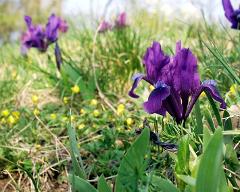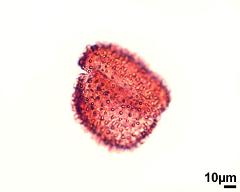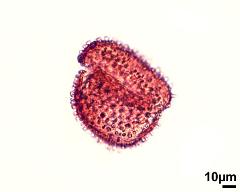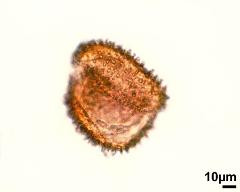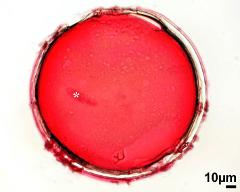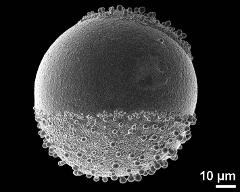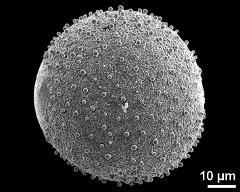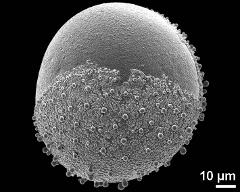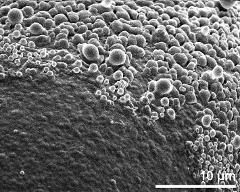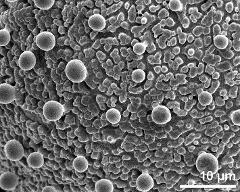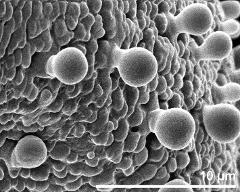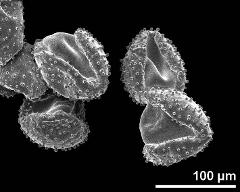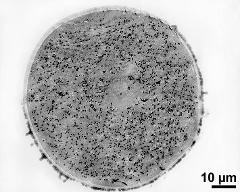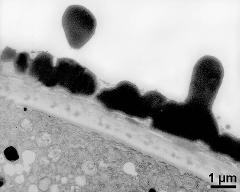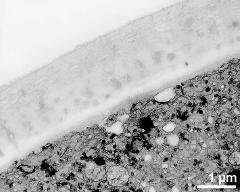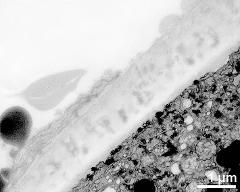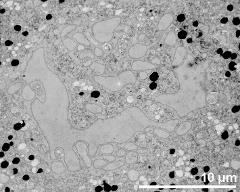Iris pumila
Taxonomy: Angiospermae, Asparagales, Iridaceae, Iris
Published: 2016-11-28
Pollen Description
Shape, Size and Aperture
pollen unit: monad, dispersal unit and peculiarities: monad, size (pollen unit): large (51-100 µm), size of hydrated pollen (LM): -, shortest polar axis in equatorial view (LM): -, longest polar axis in equatorial view (LM): -, shortest diameter in equatorial or polar view (LM): -, longest diameter in equatorial or polar view (LM): -, pollen class: sulcate, polarity: heteropolar, P/E-ratio: -, shape: spheroidal, outline in polar view: circular, dominant orientation (LM): -, P/E-ratio (dry pollen): -, shape (dry pollen): irregular, outline in polar view (dry pollen): irregular, infoldings (dry pollen): irregularly infolded, aperture number: 1, aperture type: sulcus, aperture condition: sulcate, aperture peculiarities: aperture membrane psilate
Ornamentation and Structure
LM ornamentation LM: clavate, echinate, nexine: -, sexine: -, SEM ornamentation SEM: clavate, suprasculpture SEM: -, TEM tectum: atectate, infratectum: absent, foot layer: continuous, endexine: compact-continuous, intine: monolayered, wall peculiarities: -, supratectal element: -
Miscellaneous
pollen coatings: pollenkitt, reserves in cytoplasm: lipids, cell number: 2-celled, Ubisch bodies: absent
Author(s) of diagnosis: Loos, Claudia; Halbritter, Heidemarie
Pictures
Picture legend
- flower(s), photographer: Halbritter, H.
- polar view, upper focus - fresh, acetolyzed, unstained, photographer: Loos, C.
- optical section - fresh, acetolyzed, unstained, photographer: Loos, C.
- polar view, lower focus - fresh, acetolyzed, unstained, photographer: Loos, C.
- pollen grain with generative cell (asterisk) - fixed, glutaraldehyde, aceto-carmine, photographer: Loos, C.
- polar view (distal) - fresh, rehydrated (water) & critical point dried & sputter coated with gold, photographer: Halbritter, H.
- polar view (proximal) - fresh, rehydrated (water) & critical point dried & sputter coated with gold, photographer: Halbritter, H.
- equatorial view - fresh, rehydrated (water) & critical point dried & sputter coated with gold, photographer: Halbritter, H.
- sulcus border - fresh, rehydrated (water) & critical point dried & sputter coated with gold, photographer: Halbritter, H.
- exine surface - fresh, rehydrated (water) & critical point dried & sputter coated with gold, photographer: Halbritter, H.
- exine surface - fresh, rehydrated (water) & critical point dried & sputter coated with gold, photographer: Halbritter, H.
- dry pollen grains - dry, sputter coated with gold, photographer: Halbritter, H.
- pollen grain in cross section - fresh, glutaraldehyde & osmium & potassium ferrocyanide, modified Thiéry-test, photographer: Loos, C.
- interapertural area of pollen wall - fresh, glutaraldehyde & osmium & potassium ferrocyanide, modified Thiéry-test, photographer: Loos, C.
- aperture - fresh, glutaraldehyde & osmium & potassium ferrocyanide, modified Thiéry-test, photographer: Loos, C.
- pollen wall at transition of aperture and interapertural area - fresh, glutaraldehyde & osmium & potassium ferrocyanide, modified Thiéry-test, photographer: Loos, C.
- vegetative nucleus - fresh, glutaraldehyde & osmium & potassium ferrocyanide, modified Thiéry-test, photographer: Loos, C.
Literature
- (2013) Pollen morphology of the genus Iris L. (Iridaceae) from Croatia and surrounding area: taxonomic and phylogenetic implications Plant Systematics and Evolution 299: 271-288
- (1998) Preparing living pollen material for scanning electron microscopy using 2,2-dimethoxypropane (DMP) and criticalpoint drying. Biotechnic Histochem 73: 137–143
- (1994) Exkursionsflora von Österreich : 1180
Copyright and Citation
Cite this publication as:
Loos C., Halbritter H. 2016. Iris pumila. In: PalDat - A palynological database. https://pc8.botanik.univie.ac.at/pub/Iris_pumila/302294;jsessionid=F2648A8616E6D9105DD2EC26F90A19A2; accessed 2025-01-25

